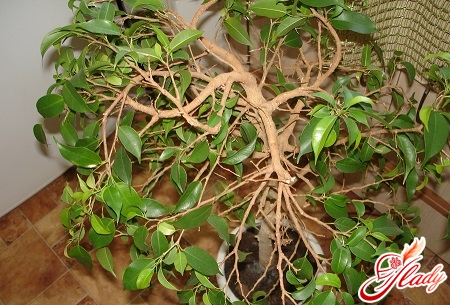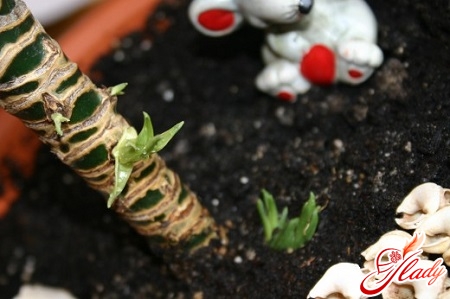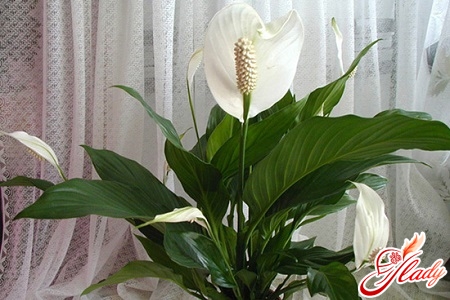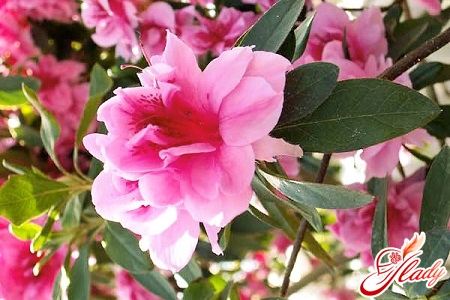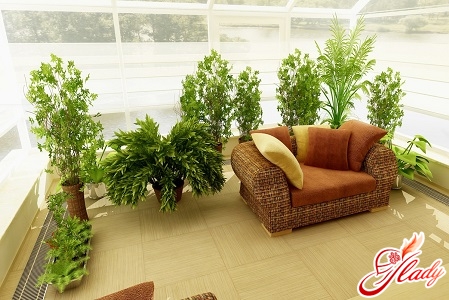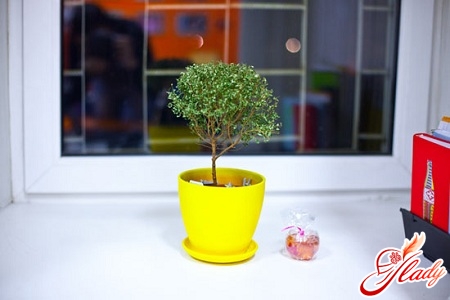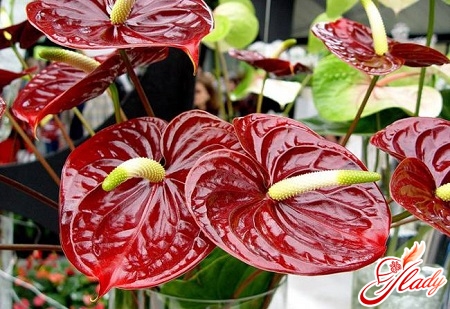 Anthurium is known in the people as a "flamingo flower"and "fiery tongue." Dense plant leaves, growing on thick stalks, can reach forty centimeters in length. This plant blooms year-round, almost without interruptions. It impresses with its beauty - the flower is truly amazing. The plant is whimsical, demanding, and in order to grow a real masterpiece, you will need both time and patience. Anthurium, home-care for which is carried out properly, will delight you and your guests with bright beautiful flowers and original colors, and will also be a worthy ornament of a flower garden.
Anthurium is known in the people as a "flamingo flower"and "fiery tongue." Dense plant leaves, growing on thick stalks, can reach forty centimeters in length. This plant blooms year-round, almost without interruptions. It impresses with its beauty - the flower is truly amazing. The plant is whimsical, demanding, and in order to grow a real masterpiece, you will need both time and patience. Anthurium, home-care for which is carried out properly, will delight you and your guests with bright beautiful flowers and original colors, and will also be a worthy ornament of a flower garden. 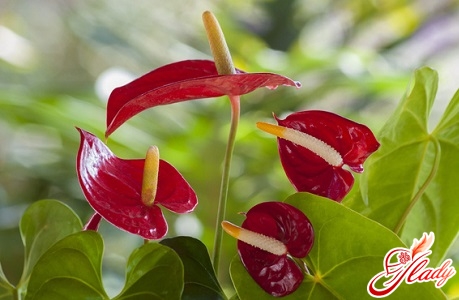
A bit about anthurium
Anthurium is a flower of a class of aroids, with a multitudesubspecies, the most common of which is Anturium Andre. This species is native to Southwest Colombia. It also grows in the north-west of Ecuador. It is distinguished by a shortened stalk and special, airy roots. Leaves on long cuttings have the form of oblong hearts in a rich green color. Flowers Andre have cylindrical cobs, usually white or yellow. Bedspread is quite dense, leathery in structure, bright and glossy. The shape of the flowers is heart-shaped. Their color can be as gentle, light pink, and bright red. Looking at the flowers of this kind of anthurium, it may seem that they are plastic - this distinctive distinguishes the plant among others. If you want to add a touch of exotics to your room, then the anthurium of Andre is ideal for this. But be careful. All aroids, whether it is a diffenbachia or an anturium, are poisonous. Therefore, if you have small children or pets, try to put the flower as high as possible, so that it is inaccessible to them. Another type of popular anthurium in the home is Anthurium Scherzer. It is an epiphyte, that is, a plant that has extremely short, often completely underground stems. More adult types of Scherzer can grow to a height of up to forty centimeters. The leaves of the plant are dark green and leathery, as in the first case. However, they are more matte and have an elliptical shape. On both sides are covered with barely noticeable black dots. The inflorescence of Scherzer, as a rule, rises above the plant itself. Strong specimens can have up to five inflorescences. The cover of the anthurium of Scherzer has a bright red color, however you can find white, pink and even mottled varieties. Another species on which to emphasize is the crystal anthurium, which is grown more like a decorative-deciduous plant. Foliage can change color from bronze and purple to saturated green. The flower has leaves up to twenty centimeters long. Their shape is cordate, with a pleasant velvety surface. The leaves hang in such a way that one can clearly see the silvery veins protruding on the surface. The petioles of the plant are smooth and rounded. Peduncles reach forty centimeters, a veil length of up to ten centimeters has a green and sometimes a purple color. 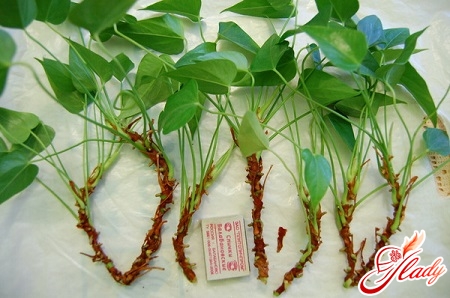
We care for an anturium
Anthurium is a flower that does not accept brightdaylight, because it can be detrimental to the growth and flowering of plants. For the anthurium, the most optimal is scattered light and partial shade. Place a pot with a flower is better near the north-west window, but remember that there should be no drafts and temperature changes. Anthurium is a plant that loves warmth. Even in winter, it needs a temperature of at least sixteen degrees. And its flowering is possible and only when the temperature reaches 22-23 degrees. In case of cooling of the root system, anthurium can become sick. For this reason, in winter, remove pots from the plant from the cold window sills, otherwise it may cool down with an earth clod, which is unacceptable. How to achieve preservation of ground heat? Transplant the flower into a plastic pot, because it is known that this material has a small thermal conductivity. If we talk about the temperature regime in general, then the most suitable temperature in the summer will be 25-28 degrees, in winter it will be enough 16-19 degrees. Try not to violate these indicators. Demanding anthurium to watering and humidity. In no case can not be dried by earthen litter, but too much waterlog does not follow. Prolonged stagnation of water can provoke rotting of the root system and the appearance of spots on the leaves, so after pouring the plant, drain the tray of excess fluid. Growing anthurium in indoor home conditions, do not forget about the simple rule: it's better to pour water than pour. Do not water the plant with water, which contains lime. Also inadmissible watering with cold water - it is better to use warmer and softer, the temperature of which exceeds the room temperature by a couple. This same water can also be used for spraying. The substrate for the anthurium must be acidic. Accordingly, if there is lime in the water, the leaves will turn yellow. Now about the humidity of the air. In order to maintain this figure is normal, do not forget to spray the flower with the finest atomizer. Spraying the plant, cover both flowers and buds - this will avoid the appearance of spots. Next to the pot, you can place a container filled with evaporating water - this will also help maintain optimum moisture. Periodically, you can use a humidifier for air, the main thing is not to overdo it. Note that an enormous number of roots (air) form on the stems of the anthurium. Such roots should be wrapped in moss, fixing them with a string of soft tissue. In autumn or winter the flower needs less watering and spraying. It is important to remember that between the watering the earth in the pot dried up on half the pot. Otherwise, the root system will begin to rot. In order for the plant to actively bloom, since September, reduce the interval between waterings. The preferred humidity for anthurium is 70-90%. This is the main problem, because it is almost impossible to achieve such an indicator in room conditions. Speaking about feeding anthurium, it is important to note that it is better to implement it in spring and summer, once in three weeks. Which fertilizer is best used? Use foliar top dressing, which must be applied directly to the leaves once a week. For an anthurium this will be enough to actively grow and blossom.
How is transplantation carried out?
Like many other plants, the anthurium followstransplanted directly in the period of active growth. This is usually the period from February to August. Try to work with the root system as accurately as possible - in anthurium it is extremely fragile and it's worthless to damage it. If the plant is young, then it must be transplanted annually. But the specimens more mature require a transplant less often, once every three to four years. During the transplant try to put the flower in the ground deeper than before. At the same time, it is necessary to distribute the drainage layer to the bottom of the pot, approximately by one third. As a drain, use, as a rule, expanded clay. After the transplant, stop the watering of the plant for several days - let the anthurium adapt to the new environment. How does breeding take place in anthuriums? The flower is best propagated vegetatively, namely by stem shoots or cuttings, on which air roots are present. The stem is easily separated from the main stem. In addition, they already have good roots. The offspring should be immediately planted in a suitable pot. If the plant has 5-6 leaves, then the pot should be about 10 centimeters in diameter. Reproduction is possible and at the expense of seeds, which must be sown immediately, once they have been harvested. Seeds are sown in an acidic substrate. However, a much simpler way is to multiply by dividing a bush, which, rather, is applicable to the flowering varieties of anthurium. In the case of ornamental-deciduous species, the first method, vegetative, is better suited. However, remember that a good transplant, as well as reproduction, is impossible if the plant has been exposed to pests. Speaking about anthurium, it is worth noting that this flower is rarely sick. However, it is not protected from harm to the scabbards and chervets, aphids or ticks. They can provoke root or stem rot, waterlogging of the substrate, as well as anthracnose. In the case of anthracnose, you can observe how the leaf plates dry at the edge. If the defeat is strong, then they are completely depleted and soon die. In the fight against this disease, do not forget to wipe the leaves of anthurium with a damp soft cloth. If the leaves began to lose decorativeness, they are removed from the plant every two months. Do not forget to make sure that new pests do not appear. Anthurium is a plant that requires maximum attention. With a little effort, ensuring proper care and protecting the anthurium from the negative influence of pests, you can grow an expressive, bright and exotic flower, which will impress with one of its kind!




